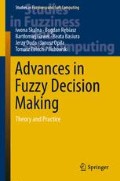Abstract
This chapter is devoted to a method which is able to process hybrid data, i.e., to jointly handle both randomness and imprecision. Random variables are described by probability distributions and imprecise values are modelled using possibility distributions. The main advantage of the proposed method is that it takes into account the dependencies between economic parameters.
Access this chapter
Tax calculation will be finalised at checkout
Purchases are for personal use only
Notes
- 1.
This cost does not account for the values of used steel products manufactured in previous stages of the cycle as well as value of used raw materials, corrections are done in order to avoid multiple calculation of the same cost components during calculation of profit, according to formula (4.1).
References
Choobineh, F., and A. Behrens. 1992. Use of intervals and possibility distribution in economic analysis. Journal of Operations Research Society 43(9): 907–918.
Baudrit, C., D. Dubois, and D. Guyonet. 2006. Joint propagation and exploitation of probabilistic and possibilistic information in risk assessment. IEEE Transaction on Fuzzy Systems 14(5): 593–607.
Gupta, C.P. 1993. A note on the transformation of possibilistic information into probabilistic information for investment decisions. Fuzzy Sets and Systems 56(2): 175–182.
Kuchta, D. 2001. Miękka matematyka w zarza̧dzaniu: zastosowanie liczb przedziałowych i rozmytych w rachunkowości zarza̧dczej. Wrocław: Oficyna Wydawnicza Politechniki Wrocławskiej.
Pluta, W., and T. Jajuga. 1995. Inwestycje: Capital Budgeting—Budżetowanie Kapitałowe. Fundacja Rozwoju Rachunkowości w Polsce.
Dittmann, P. 2008. Prognozowanie w przedsiȩbiorstwie: metody i ich zastosowanie. Wolters Kluwer.
Kuchta, D. 2000. Fuzzy capital budgeting. Fuzzy Sets and Systems 111(3): 367–385.
Mohamed, S., and A.K. McCowan. 2001. Modelling project investment decisions under uncertainty using possibility theory. International Journal of Project Management 19(4): 231–241.
Ferson, S. 1996. What Monte Carlo method cannot do. Human and Ecological Risk Assessment: An International Journal 2(4): 990–1007.
Georgescu, I., and J. Kinnunen. 2011. Modeling the risk by credibility theory. In Proceedings of the 3rd international IEEE conference on advanced management science (ICAMS 2011), Kuala Lumpur, Malaysia, International proceedings of economics development and research, vol. 19, 15–19.
Chiu, C.-Y., and S.C. Park. 1994. Fuzzy cash flow analysis using present worth criterion. The Engineering Economist 39(2): 113–138.
Rȩbiasz, B. 2013. Selection of efficient portfolios-probabilistic and fuzzy approach, comparative study. Computers and Industrial Engineering 64(4): 1019–1032.
Rȩbiasz, B. 2007. Fuzziness and randomness in investment project risk appraisal. Computers and Operations Research 34(1): 199–210.
Ferson, S., and L.R. Ginzburg. 1996. Difference method are needed to propagate ignorance and variability. Reliability Engineering and System Safety 54(2–3): 133–144.
Cooper, J.A., S. Ferson, and L. Ginzburg. 1996. Hybrid processing of stochastic and subjective uncertainty data. Risk Analysis 16(6): 785–791.
Ward, T.L. 1985. Discounted fuzzy cash flow analysis. In 1985 Fall Industrial engineering 476–481.
Buckley, J.J. 1992. Solving fuzzy equations in economics and finance. Fuzzy Sets and Systems 48(3): 289–296.
Calzi, M.L. 1990. Toward a general setting for the fuzzy mathematics of finance. Fuzzy Sets and Systems 35(3): 265–280.
Esogbue, A.O., and W.E. Hearnes II. 1998. On replacement models via a fuzzy set theoretic framework. IEEE Transactions on Systems Manufacturing and Cybernetics—Part C: Applications and Reviews 28(4): 549–560.
Kahraman, C., D. Ruan, and E. Tolga. 2002. Capital budgeting techniques using discounted fuzzy versus probabilistic cash flows. Information Science 142(1–4): 57–76.
Rȩbiasz, B., B. Gaweł, and I. Skalna. 2014. Capital budgeting of interdependent projects with fuzziness and randomness. In Information systems architecture and technology, ed. Zofia Wilimowska et al, 125–135.
Rȩbiasz, B., B. Gaweł, and I. Skalna. 2015. Fuzzy multi-attribute evaluation of investments. In Advances in ICT for business, industry and public sector: ABICT’13 (4th international workshop on Advances in business ICT), eds. Tomasz Pełech-Pilichowski Maria Mach-Król, and Celina M. Olszak, 141–156.
Rȩbiasz, B., B. Gawel, and I. Skalna. 2014. Hybrid framework for investment project portfolio selection. In Federated conference on computer science and information systems 1123–1228.
Smets, P. 1990. Constructing the pignistic probability function in a context of uncertainty. In Proceedings of the fifth annual conference on uncertainty in artificial intelligence, ed. Henrion M., E.D. Schachter, L.N. Kanal, and J.F. Lemmer. UAI’89, 29–39. Amsterdam: North-Holland Publishing Co.
Shafer, G. 1976. A mathematical theory of evidence. Princeton: Princeton University Press.
Guyonnet, D., B. Bourgine, D. Dubois, H. Fargier, B. Côme, and P.J. Chilès. 2003. Hybrid approach for addressing uncertainty in risk assessment. Journal of Environmental Engineering 129(1): 68–76.
Kaufmann, A., and M.M. Gupta. 1985. Introduction to fuzzy arithmetic: Theory and application., Electrical-computer science and engineering series New York: van Nostrand Reinhold Company.
Puri, M.L., and D.A. Ralescu. 1985. The concept of normality for fuzzy random variables. Annals of Probability 13(4): 1371–1379.
Liu, Y.-K., and B. Liu. 2003. Fuzzy random variables: A scalar expected value operator. Fuzzy Optimization and Decision Making 2(2): 143–160.
Liu, Y.-K., and B. Liu. 2003. Expected value operator of random fuzzy variable and random fuzzy expected value models. International Journal of Uncertainty, Fuzziness and Knowledge-Based Systems 11(2): 195–215.
Liu, Y.-K., and B. Liu. 2002. Expected value of fuzzy variable and fuzzy expected value models. IEEE Transactions on Fuzzy Systems 10(4): 445–450.
Zadeh, L.A. 1978. Fuzzy sets as a basis for a theory of possibility. Fuzzy Sets and Systems 1(1): 3–28.
Author information
Authors and Affiliations
Corresponding author
Rights and permissions
Copyright information
© 2015 Springer International Publishing Switzerland
About this chapter
Cite this chapter
Basiura, . et al. (2015). Risk Assessment in the Presence of Uncertainty. In: Advances in Fuzzy Decision Making. Studies in Fuzziness and Soft Computing, vol 333. Springer, Cham. https://doi.org/10.1007/978-3-319-26494-3_5
Download citation
DOI: https://doi.org/10.1007/978-3-319-26494-3_5
Published:
Publisher Name: Springer, Cham
Print ISBN: 978-3-319-26492-9
Online ISBN: 978-3-319-26494-3
eBook Packages: EngineeringEngineering (R0)

